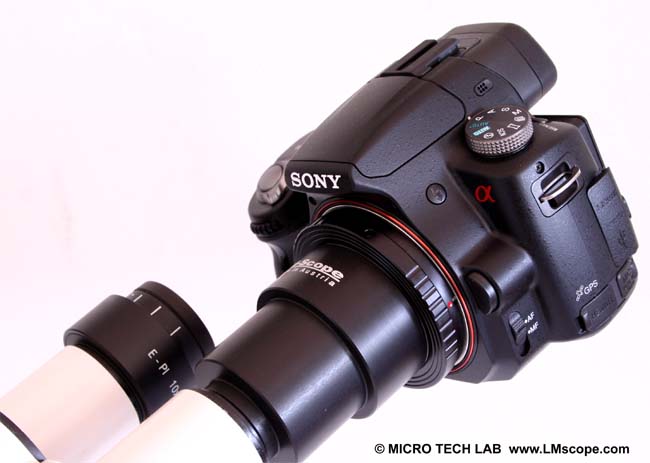

Adapter solution for WILD/Leica microscopes with elbowed beam splitters
Wild and Leica microscopes featuring angled beam splitters can be easily fitted for high-quality photomicrographic applications with our LM digital adapters. These microscopes are particularly well suited for connecting modern DSLR, video (HD/4k/6k), C-mount and system cameras.

Although slightly older models, the Leica and Wild microscopes of the M series (Wild M3, M10/Leica MS5, MZ6, MZ7, MZ9, MZ APO) still provide superb optical quality and are therefore excellently suited for producing sophisticated photographic documentation.
They feature coaxial illumination, a large field of vision and high resolution. Due to the modular system of components, they also offer a high degree of flexibility in terms of equipment and use.
The elbowed photo tube is available in two different designs. The HU phototube (Wild product no. 404891) directs 100% of the light from the adjacent eyepiece tube to the camera, while the object can still be observed monocularly through the other eyepiece. The HV photo tube (Wild product no. 18057), on the other hand, is equipped with a control lever that lets the user switch to photography use. In that case, 50% of the light is passed to the photo tube and the remaining 50% is directed to the two eyepiece tubes.
Both photo tube formats (HU and HV) have an integrated double iris diaphragm that can be operated with a diaphragm lever. The purpose of the iris diaphragm is to increase the depth of field and adjust the light intensity of the camera system.
The elbowed photo tube of the similarly designed Leica microscope models (MS5, MZ6, MZ7, MZ9, MZ APO) has the Leica product number 10446174.
If the microscope does not have a photo tube, it is always possible to mount a camera to the eyepiece tube. This does not make any difference in the optical quality compared to the solution that uses the photo tube.
Photography:
Fitting the microscope to digital single-lens reflex (DSLR), mirrorless interchangeable-lens cameras (MILC ), digital single-lens mirrorless (DSLM) or C-mount cameras is easy with our LM digital SLR adapters, which feature a plan achromatic optical system. Our products make it possible to capture top-quality microscope images. To help you select the adapter that is right for your camera, we have set up an online configurator on our website. You can also email us – ideally with attached photographs of your microscope.
Modern DSLR and single-lens mirrorless (DSLM) offer the latest technology and are generally very well suited for microscopy applications. Most of them can be controlled remotely via PC/Mac. Because of their high sales volumes, they offer an excellent price/performance ratio compared to special-purpose microscope cameras.
Features of top DSLR and single-lens mirrorless cameras (DSLM):
- Large, powerful full-frame sensors (36 x 24 mm)
- Sensor resolution of 61 megapixels or 240 megapixels with Pixel Shift technology
- High light sensitivity (ISO 400,000+)
- Extensive dynamic range (up to 15 aperture stops/f-stops)
- Short exposure times (1/8000 second) up to 1/32,000 seconds using the digital shutter
- 4K Ultra HD or 8K Ultra HD video function
- Live video capture on external monitors in ultra HD quality
In most cases, these cameras are significantly more powerful than microscope cameras with smaller sensors (1/2" or 2/3"). On our website you will find our current camera recommendations and a camera ranking which is specifically tailored to microscopy applications.
New LM Digital Adapter for: Sony Alpha 9 III / Nikon Z9 / Nikon Z8 / Sony Alpha 7R V / Sony Alpha 1 II / Sony Alpha 1 / Sony Alpha 9 II (ILCE-9M2) / Sony FX3 Cinema Line / Sony Alpha 9 / Nikon D6 / Canon EOS R3 / Canon EOS R6 Mark II / Canon EOS R8 / Sony Alpha 7R IV / Canon EOS R5 II / Nikon Z6III / Canon EOS R5 / Sony Alpha 7S II / Sony Alpha 7S III / Sony Alpha 7R III / Canon EOS R6 / Nikon Z6 / Nikon Z6II / Sony Alpha 7R II / Nikon Z7 / Nikon Z7II / Canon EOS R / Canon EOS Ra (Astro) / Nikon Z5 / Sony Alpha 7C / Canon EOS RP / Sony Alpha 7S / Canon EOS R7 / Leica SL2-S / Canon EOS R10 / Nikon Z50 II / Canon EOS 1D X Mark III / Nikon Z50 / Nikon Z30 / Nikon Z fc / Nikon D850 /
